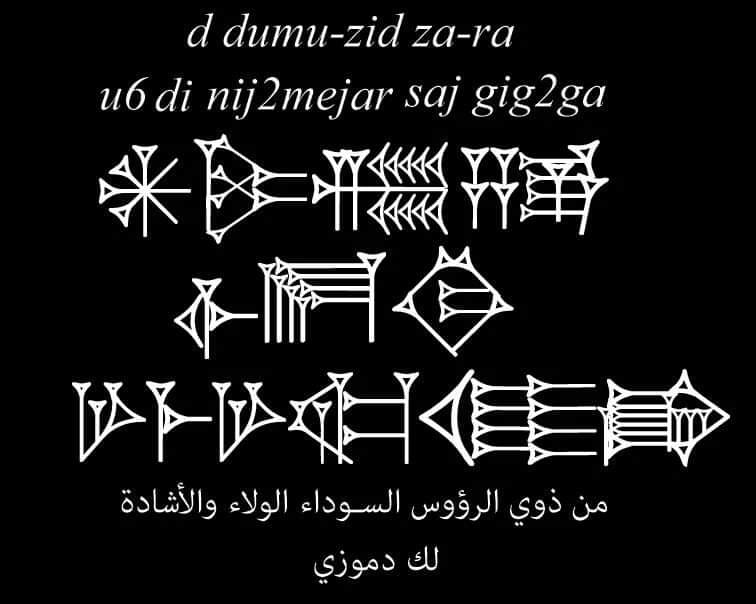Various popular beliefs

The ancient Sumerian and Babylonian epics and writings indicate that plant seeds were a divine gift that came from heaven. The Sumerians believed that natural herbal plants were created much before cultivated plants. And all of this is a tribute from the sacred sky to the black-haired Sumerians and their sacred land.
Although there are Sumerian epics that can be interpreted with less fantasy, and that they are only an expression of natural forces, translators like Kramer went far in creating myths and flattening the Sumerian mind from them.
As in the struggle between Enki and the god of the underworld, Kur. The legend only says that Kor hit Enki with small and large stones and poured upon him the “first waters,” meaning very close to the eruption of volcanoes in the interior of the Earth and their spewing of stones and magma. This is a Sumerian description of the state of the Earth at its beginning, in what reveals their knowledge - from During the prophets, perhaps - in the history of the creation of the Earth, but the translators made it a battle between two mythical gods in a fantasy, imaginary place. Despite some of them objecting to each other, due to doubts about their translations, as Jacobson did with Kramer's translation.
Hence, the epic of Ninurta against Asag, the monster of the underground (Kor), who spilled on the earth ancient water unfit for irrigation and use and caused it to overflow the land of Sumer, was nothing but a natural accident of volcanic eruptions that caused floods and gray clouds that caused suffocation and poisoned the waters of the rivers. So Ninurta, with the blessing of Ninmakh, blocked those internal outlets, dropped pure rain, and drained the bad water that overflowed into the course of the Tigris River, so that the land of Sumer returned to life. Therefore, all Western translations of this story are another unnecessary fantasy.
This is also the epic of Inanna against Kor, who was represented by the “mountain” this time on the Iranian-Iraqi border, perhaps, where Kor caused problems to the holy cities in Sumer, so Inanna dealt with what he had caused. It may have caused a flood, or a volcanic or oil explosion, from among the mountains there.
This is sufficient to explain the legend of the struggle between Ninurta and the winged bird Enzu. The latter controlled the land and the mountains, and was obedient to the god (Enlil). Then he stole the “tablets of destiny” and controlled the destinies of those on earth, until Ninurta killed him with storms, lightning, and piercing arrows. After Ninurta made the earth dark and stormy, it disappeared. From the sun, he then returned the “Tablets of Destiny” to Sumer. Because this myth may have only talked about the natural phenomenon that caused the extinction of the giant flying dinosaurs, which dominated the destinies and lives of living creatures on Earth, until they were destroyed by a cosmic catastrophe, represented by the entity (Ninurta), after the failure of other entities, and caused the Earth to become dark and stormy. And the spread of projectiles there, The authority of the Earth later returned - after the absence of this great opponent - to humans who controlled its nature with their mind, and he would not have had that if those huge monstrous creatures had remained. This is why the legend of “The Bird (Enzo) and the Tablets of Destiny” stated that this being was born from the natural abundance of the gods, within the formation and context that they conducted in the formation system on Earth. It was also mentioned in other legends that there were many who participated in confronting this bird, perhaps because of the contribution of many in getting rid of its remains on earth, so celebrating its extinction remained a major occasion in Sumerian thought.
In this way, it is also possible that the “giant dragon monster (Labbu)”, which was killed by the Sumerian gods, is a major, unique natural phenomenon that began in the ocean and affected the entire Earth. Hence, the echo of this “dragon” phenomenon is mentioned in many myths of other civilizations. The story of the “dragon” was also mentioned in the Bible (Isaiah 27:1 and Isaiah 51:9). However, fossil remains were discovered by the director of the Desert Museum (Osvaldo Rojas) of a flying dragon in the Atacama Desert in Chile. It belonged to a type of dinosaur (pterosaur) from the Jurassic period, that is, approximately 160 million years ago. It had a tail. Long, pointed, with wings and sharp, prominent teeth, they are coastal dinosaurs that were spread in the south and north of the globe, where the Atacama Desert - according to scientists - was submerged in ocean water at that time.
Source: websites

